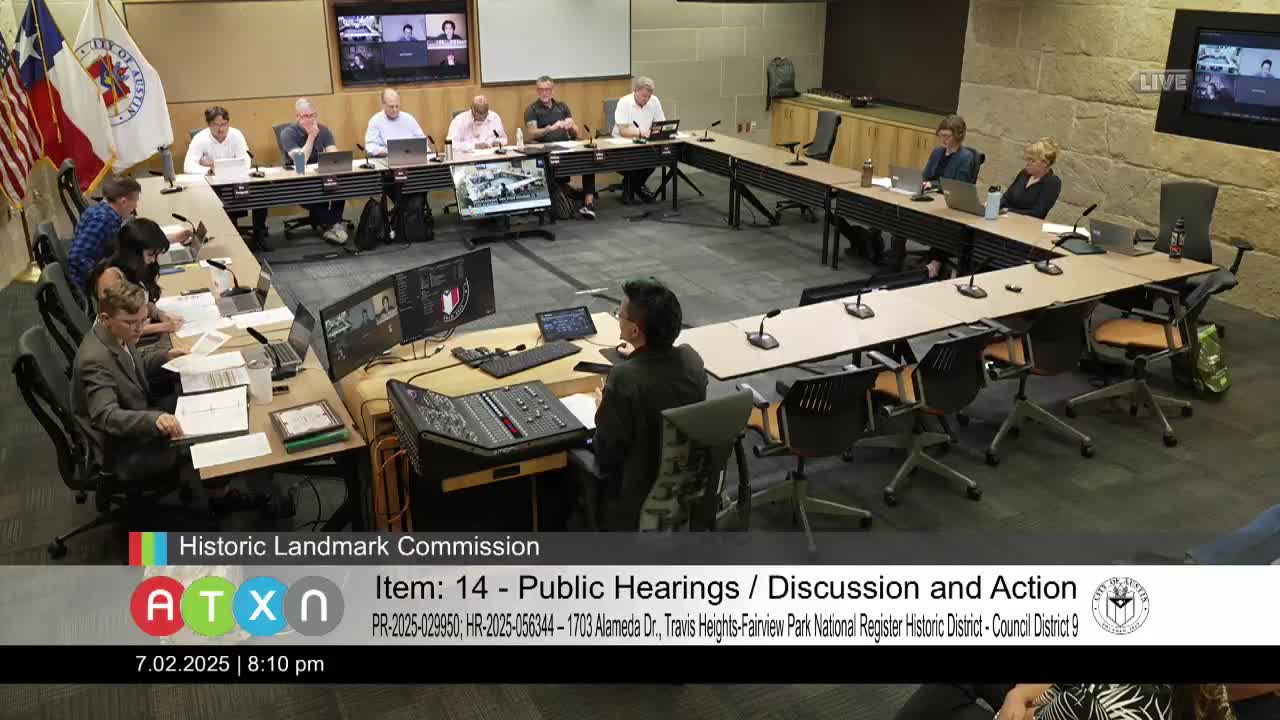Travis Heights review committee discusses demolition proposal for 1939 bungalow on Alameda Drive
July 02, 2025 | Austin, Travis County, Texas
This article was created by AI summarizing key points discussed. AI makes mistakes, so for full details and context, please refer to the video of the full meeting. Please report any errors so we can fix them. Report an error »

In a recent government meeting held on July 2, 2025, the Austin City Council discussed a proposal to demolish a historic home located at 1703 Alameda Drive, built in 1939, and replace it with a new residence. The existing structure, characterized by its simple, minimal traditional design, has been largely unaltered since its construction and is considered to contribute to the historic character of the Travis Heights neighborhood.
The proposal has sparked significant debate among community members and preservation advocates. The applicant, Brian Randall, expressed a desire to modernize the property to better accommodate the needs of aging family members. He emphasized that the new design would draw inspiration from the existing architectural elements of the neighborhood, aiming to blend with the historic aesthetic while fulfilling the functional requirements of the homeowners.
However, the Architectural Review Committee (ARC) raised concerns regarding the proposed demolition. They noted that the existing house, despite its modest condition, represents a significant aspect of the neighborhood's history. Several community members, including representatives from the South River City Citizens Historic Preservation Committee, urged the council to reconsider the demolition, advocating for renovation alternatives that could preserve the character of the area.
Critics of the demolition highlighted the importance of maintaining the neighborhood's architectural diversity, particularly as the existing home is one of the few remaining modest structures in a district increasingly dominated by larger developments. They argued that the proposed new construction does not align with the design standards set forth for the National Register Historic District, which requires careful consideration of the impact on the community's historical context.
The council's staff recommended approving the demolition permit while providing feedback on the new construction plans. However, the lack of community engagement prior to the application submission raised further concerns about the potential loss of historical integrity in the neighborhood.
As discussions continue, the future of the property remains uncertain. The council is expected to weigh the benefits of modernization against the community's desire to preserve its historical roots. The outcome of this proposal could set a precedent for similar cases in the rapidly evolving landscape of Austin's historic districts.
The proposal has sparked significant debate among community members and preservation advocates. The applicant, Brian Randall, expressed a desire to modernize the property to better accommodate the needs of aging family members. He emphasized that the new design would draw inspiration from the existing architectural elements of the neighborhood, aiming to blend with the historic aesthetic while fulfilling the functional requirements of the homeowners.
However, the Architectural Review Committee (ARC) raised concerns regarding the proposed demolition. They noted that the existing house, despite its modest condition, represents a significant aspect of the neighborhood's history. Several community members, including representatives from the South River City Citizens Historic Preservation Committee, urged the council to reconsider the demolition, advocating for renovation alternatives that could preserve the character of the area.
Critics of the demolition highlighted the importance of maintaining the neighborhood's architectural diversity, particularly as the existing home is one of the few remaining modest structures in a district increasingly dominated by larger developments. They argued that the proposed new construction does not align with the design standards set forth for the National Register Historic District, which requires careful consideration of the impact on the community's historical context.
The council's staff recommended approving the demolition permit while providing feedback on the new construction plans. However, the lack of community engagement prior to the application submission raised further concerns about the potential loss of historical integrity in the neighborhood.
As discussions continue, the future of the property remains uncertain. The council is expected to weigh the benefits of modernization against the community's desire to preserve its historical roots. The outcome of this proposal could set a precedent for similar cases in the rapidly evolving landscape of Austin's historic districts.
View full meeting
This article is based on a recent meeting—watch the full video and explore the complete transcript for deeper insights into the discussion.
View full meeting
